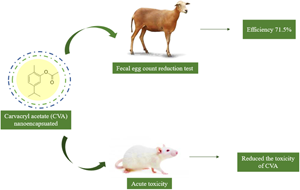Article contents
Carvacryl acetate nanoencapsulated with chitosan/chichá gum exhibits reduced toxicity in mice and decreases the fecal egg count of sheep infected with gastrointestinal nematodes
Published online by Cambridge University Press: 09 July 2021
Abstract

The nanoencapsulation of biocomposites with anthelmintic action has been proposed as an alternative for improving their efficiency. Thus, the current study aimed to evaluate the efficacy of carvacryl acetate nanoencapsulated with biopolymers (nCVA) in the control of sheep gastrointestinal nematodes. CVA was nanoencapsulated with chitosan/chichá gum and characterized in terms of its efficacy of encapsulation (EE), yield and zeta potential. The acute toxicity of nCVA was evaluated in mice. For the fecal egg count reduction test, 40 animals were divided into four groups (n = 10) and orally administered the following treatments: G1, 250 mg kg−1 CVA; G2, 250 mg kg−1 nCVA; G3, chitosan/chichá gum (negative control) and G4, 2.5 mg kg−1 monepantel (positive control). Feces were collected on days 0 and 16 posttreatment to determine the eggs per gram of feces (epg). The EE and yield of nCVA were 72.8 and 57.5%, respectively. The nanoparticles showed a size of 764.5 ± 302.5 nm, and the zeta potential at pH 3.2 was +22.0 mV. nCVA presented a 50% lethal dose (LD50) of 2609 mg kg−1. By 16 days posttreatment, CVA, nCVA and monepantel reduced the epg by 52.9.7, 71.5 and 98.7%, respectively, and the epg of sheep treated with nCVA differed from that of the negative control (P > 0.05) but did not differ from that of sheep treated with CVA. In conclusion, the nanoencapsulation of CVA reduced its toxicity, and nCVA showed anthelmintic activity.
- Type
- Research Article
- Information
- Copyright
- Copyright © The Author(s), 2021. Published by Cambridge University Press
References
- 1
- Cited by





